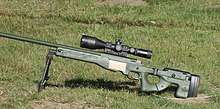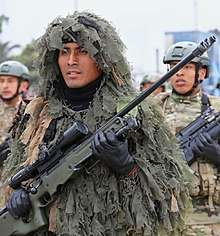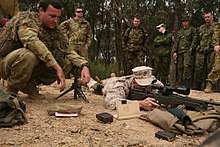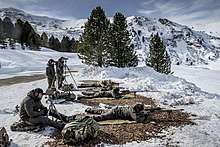Accuracy International Arctic Warfare
The Accuracy International Arctic Warfare rifle is a bolt-action sniper rifle designed and manufactured by the British company Accuracy International. It has proved popular as a civilian, police, and military rifle since its introduction in the 1980s. The rifles have some features that improve performance in very cold conditions (which gave the rifle its name) without impairing operation in less extreme conditions.
| Accuracy International Arctic Warfare | |
|---|---|
 | |
| Type | Sniper rifle |
| Place of origin | United Kingdom |
| Service history | |
| In service | 1982 (L96A1), 1988 (AW), 1990–present |
| Used by | See Users |
| Wars | Iraq War Afghanistan War Insurgency in the North Caucasus[1] Syrian Civil War[2] |
| Production history | |
| Designed | 1982 (PM), 1983 (AW) |
| Manufacturer | Accuracy International |
| Produced | 1982–present |
| Specifications | |
| Mass | 6.5 kg (14.3 lb) |
| Length | 1,180 mm (46.5 in) |
| Barrel length | 660 mm (26.0 in) |
| Cartridge | 7.62×51mm NATO (.308 Winchester) .338 Lapua Magnum |
| Action | Bolt-action |
| Muzzle velocity | 850 m/s (2,790 ft/s) |
| Effective firing range | 800 m (870 yd) |
| Maximum firing range | 3,943 m (4,312 yd)[3] |
| Feed system | 10-round double stack detachable box magazine (.308) 5-round single stack detachable box magazine (.300, .338) |
| Sights | detachable aperture type iron sights day or night optics |
Arctic Warfare rifles are generally fitted with a Schmidt & Bender PM II telescopic sight with fixed or variable magnification. Variable telescopic sights can be used if the operator wants more flexibility to shoot at varying ranges, or when a wide field of view is required. Accuracy International actively promotes fitting the German-made Schmidt & Bender MILITARY MK II product line as sighting components on their rifles, which is rare for a rifle manufacturer. The German and Russian forces preferred a telescopic sight made by Zeiss[4] over Accuracy International's recommendation.
History
Original design
The Accuracy International PM (Precision Marksman) rifle was entered into a British competition in the early 1980s as a replacement for the Lee–Enfield derived sniper rifles then in use by the British Army (e.g. L42A1). The Accuracy International rifle was selected over the Parker Hale M85. The British Army adopted the Accuracy International PM in 1982 into service as the L96A1 and outfitted the rifle with Schmidt & Bender 6×42 telescopic sights. In this configuration the rifle is capable of first shot hits with a cold, warm or fouled barrel. Tests with 10.89 g (168 gr) ammunition provided sub 0.5 MOA ten-shot groups at 91 m (100 yd) and the rifle was supplied with a telescopic sight, bipod, five magazines, sling, cleaning kit and tool roll, encased in a fitted transport case.[5]
Design evolution

Some years later, the Swedish military also wanted a new rifle, and in the early 1990s Accuracy International entered an upgraded version of the PM, now known as the AW (Arctic Warfare). This was the start of the Arctic Warfare name, which became the primary name of the rifle family despite its earlier names.
Special de-icing features allow it to be used effectively at temperatures as low as −40 °C (−40 °F). The AW rifle featured a modified bolt with milled slots in the bolt body end to prevent bolt binding problems caused by penetrating water/ice, dirt or similar disturbances. Further, the stockhole, bolt handle, magazine release and trigger guard on the AW were enlarged and the magazine floorplates got protruding grasping tabs to allow use with heavy Arctic mittens. The resin stock side panels were replaced with sturdier polymer panels. The safety was revised to a 3-position safety allowing the bolt to be cycled with a locked trigger. This version was accepted into use by the Swedish Army in 1991 as the Prickskyttegevär 90 (Psg 90) fitted with a 10×42 Hensoldt telescopic sight.
The modifications to the original PM or L96A1 made the British Army decide to adopt the "improved" AW version as well, designated L118A1 (fixed stock variant) and L118A2 (folding stock variant) . The rifles were fitted with Schmidt & Bender MILITARY MK II 3-12×50 telescopic sights offering the operator more flexibility to shoot at varying ranges, or in situations when a wide field of view is required. The stocks were fitted with a butt spike. This rifle has seen service in conflicts such as Operation Granby and Operation Telic.
In 2011 some Swedish Psg 90 rifles were modernised to the Prickskyttegevär 90B (Psg 90B) standard fitting Schmidt & Bender MILITARY MK II 3-12×50 telescopic sights and folding stocks.
Rifle system family
The Accuracy International Arctic Warfare model has since spawned an entire family of sniper rifles using the Arctic Warfare name, and has been adopted by a number of other countries, including Australia, Belgium, Germany, Indonesia, Ireland, Latvia, Malaysia, Norway, the Netherlands, New Zealand, Russia, Singapore, Spain, Sweden and the United Kingdom. Other AI rifles descended from the L96A1 include the AI AE, and the AI AS50 (see variants below).
Most Arctic Warfare rifles are chambered for the 7.62×51mm NATO cartridge, but Accuracy International also made variants of the sniper rifle, the AWM (Arctic Warfare Magnum) chambered either for the .300 Winchester Magnum and the .338 Lapua Magnum and the AW50 (Arctic Warfare .50 calibre) chambered for the .50 BMG (12.7×99mm NATO). The sniper rifles are mounted with a muzzle brake in order to help reduce the recoil, muzzle raise and muzzle flash of the weapon.
Each country's rifles differ slightly. The Swedish Psg 90 for example, uses a Hensoldt (Zeiss) scope and can also use sabot rounds. In 1998, the German Bundeswehr adopted the first folding-stock Arctic Warfare Magnum (AWM-F) chambered in .300 Winchester Magnum (7.62×67mm) and with optics made by the German company Zeiss, and designated as the Scharfschützengewehr 22 (G22).
The AW's complete parts interchange ability and reliability in adverse weather conditions have made it a popular, if expensive, weapon. The rifle offers good accuracy (a capable marksman can expect ≤ 0.5 MOA consistent accuracy with appropriate ammunition), and its maximum effective range with a Schmidt & Bender 6×42 PM II scope is around 800 metres (870 yd).
The Arctic Warfare family's main competitor in production of high-end factory sniper rifles is the Sako TRG product line, with similar capability but lower price than the Arctic Warfare system.
Design details
The AW system is almost unique in being a purpose-designed military sniper rifle, rather than an accurised version of an existing general-purpose rifle.
The modular design of the AW system allows for flexibility, serviceability and repairability under field and combat conditions. Major components, such as the barrel and the bolt, can be switched between rifles, or replaced in the field by their operator with the help of some tools. The chambering can also be switched by the operator as long as the barrels, bolts and feeding mechanism can handle the shape and size of the cartridges.[6]
Features

Rather than a traditional wooden or polymer rifle stock, the AW is based on an aluminium chassis which extends the entire length of the stock. This chassis system is marketed as the Accuracy International Chassis System (AICS) and can be used for all Accuracy International rifles. All other components, including the receiver, are bolted directly to this chassis. Two hollow polymer "half thumb-hole stock panels", usually coloured green, dark earth or black, are in turn bolted to each other through the chassis, creating a rugged yet, for its sturdiness, comparatively light weapon.
The Accuracy International receiver is bolted with four screws and permanently bonded with epoxy material to the aluminium chassis, and was designed for ruggedness, simplicity and ease of operation. To this end, the heavy-walled, flat-bottomed, flat-sided receiver is a stressed part, machined in-house by AI from a solid piece of forged carbon steel. AW rifles are supplied in two action lengths—standard AW (short) and long SM (magnum). The six bolt lugs, arranged in two rows of three, engage a heat-treated steel locking ring insert pinned inside the front bridge of the action. The ring can be removed and replaced to refresh headspace control on older actions. The AW system cast steel bolt has a 0.75-inch (19.05 mm) diameter combined with gas relief holes in a 0.785 in (19.9 mm) diameter bolt body and front action bridge allowing high-pressure gases a channel of escape in the event of a cartridge-case head failure. Against penetrating water or dirt the bolt has milled slots, which also prevent freezing or similar disturbances. Unlike conventional bolt-action rifles, the bolt handle is bent to the rear, which eases the repeating procedure for the operator and reduces the contour of the weapon. The action cocks on opening with a short, 60 degree bolt throw and has a non-rotating (fixed) external extractor and an internal ejector. Firing pin travel is 0.26 in (6.6 mm) to keep lock times to a minimum. Finally, an 11 mm (0.43 in) integral dovetail rail located above the receiver is designed to accommodate different types of optical or electro-optical sights. As an option, a MIL-STD-1913 rail (Picatinny rail) can be permanently pinned, bonded and bolted to the action, providing a standard interface for many optical systems.
Ammunition feeding
Cartridges are fed through the bottom of the receiver using a detachable, double-column, steel box magazine. Rifles chambered for .300 Winchester Magnum or larger use a single row magazine. Alternatively cartridges can be loaded singly directly into the chamber.
Barrel
The free-floating, heavy, stainless steel barrels (stainless steel resists throat erosion better than normal barrels) for the available cartridge chamberings all have a different length, groove cutting and rifling twist rate optimised for their chambering and intended ammunition. For .243 Winchester, the twist rate is 254 mm (1 in 10 in), and for .308 Winchester/7.62×51mm NATO variants it is 305 mm (1 in 12 in), except for the suppressed-barrel variant. If the consistent accuracy requirement of an operator is no longer met, the barrel can fairly easily be renewed. This is normal practice for active high-performance precision rifle operators, who regard barrels as replaceable. The barrels are provided by Australian company Maddco Rifle Barrels (button rifled), and Scottish company Border Barrels, who cut-rifles them on Pratt & Whitney rifling benches. Twists are one turn in 10, 11, 12, 13 and 14 inches for 7.62 MM depending on RFP.
Safety
A three-position, firing pin blocking safety lever on the bolt shroud allows the bolt to be manipulated with the safety on. If the weapon is cocked, the firing pin can be felt at the end of the bolt action, making it possible in poor visibility to feel whether the weapon is ready to fire. The safety-catch of the weapon is also positioned at the rear, showing white if the safety is on, red if not.
Trigger
The two-stage trigger mechanism has an adjustable trigger pull weight of 10 to 20 N (2.2 to 4.4 lbf). The trigger assembly can be easily removed for cleaning by undoing two socket-head cap screws.
Accessories
.jpg)
The AW is usually equipped with an integrated bipod and it also has a monopod mounted on the buttstock.
Accuracy International accessories for the Arctic Warfare system[7] include a selection of PM II series telescopic sights made by Schmidt & Bender with laser filters for the military scopes, aluminium one-piece telescopic sight mounting sets, MIL-STD-1913 rails (Picatinny rails), lens hoods, various optical and kill flash filters and lens covers for telescopic sights, auxiliary iron sights for emergency use, cleaning kits, muzzle brakes/flash-hiders and suppressors, butt plates and spacers to regulate the length of pull and butt angle to the requirements of the individual shooter, buttspikes, bipod (adapters), handstops, mirage bands, soft and heavy-duty transit cases and various maintenance tools.[8]
Accuracy International Chassis System

The Accuracy International Chassis System (AICS) can be configured for various actions (all Accuracy International and some Remington 700 receivers), triggers, and other items. The AICS version for Remington 700 receivers was introduced in 1999. U.S. distributors started selling AICS chassis systems in late 2012 for Savage Arms' Model 10 series of precision long range rifles. These Savage Arms rifles are primarily for the law enforcement applications. There are three variants of AICS chassis system. The basic variant is the AICS 1.0 with a fixed cheek-piece. The AICS 1.5 variant has a fully adjustable cheek-piece. The AICS 2.0 is a folding stock that reduces the rifle's overall length by 210 mm (8.3 in) when folded and adds 0.2 kg (0.44 lb) to the rifle's total weight. The AICS 1.5 and 2.0 both have cheek-piece design that adjusts sideways and for height for optimal cheek position when using night vision equipment, or telescopic sights with large objective lenses. There is also a quick-adjust cheek-piece option that has a spring-loaded cheek-piece in conjunction with a quick-adjust butt plate.
The AICS side panels are made from a high-strength polymer and are available in the colours olive drab, dark earth or black.
Sling attachment points are mounted on each side of the rifle, so it can be carried flat against the back and used comfortably by left- and right-handed users. A front attachment point is situated below the fore end and can be used to anchor a target style sling or replaced by an adapter for a Harris bipod.
Mk 13

The United States Special Operations Command uses the AICS as the Mk 13 Mod 5 rifle chambered in .300 Winchester Magnum. The Mk 13 Mod 5 utilises the "long-action" bolt of the Remington 700/M24 receiver and has a precision barrel that can be fitted with the suppressor of the Mk 11. It has a 3-sided Modular Accessory Rail System (MARS) for mounting optics on top and Picatinny rail accessories on each side, and a folding bipod.[9] The Mk 13 is to be gradually replaced by the Modular Sniper Rifle in US Army use.[10]
Mk 13 Mod 7
In April 2018, the U.S. Marine Corps announced they would be replacing the M40 sniper rifle with the Mk 13 Mod 7; the M40 had been in service with the Marines since 1966, with the latest M40A6 being upgraded in 2014. The Mk 13 chambered in .300 Winchester Magnum increases range from 1,000 metres with the M40 to 1,300 metres, giving Marine snipers similar capabilities to the U.S. Army M2010 Enhanced Sniper Rifle.[11]
AX AICS stock
An AX series Accuracy International Chassis System (AICS) stock is also available for Remington 700 short and long bolt action based rifles.[12][13]
AT AICS stock
An AT series Accuracy International Chassis System (AICS stock) is also available for Remington 700 short and long bolt action based rifles, Savage M10 short action and Tikka T3 short action rifles.
Variants
| Accuracy International rifles |
|
AI Arctic Warfare |
There are two main types of AW series models. Models offered by AI, and type classified models in service with governments. AW models are related to, but not necessarily exactly synonymous with specific models adopted by countries.[14]
PM (Precision Marksman)
The rifle from which the Arctic Warfare family was developed. In this original form, it entered service in the UK in the mid-1980s, and designated as the L96A1 (chambered for 7.62×51mm NATO).
AW (Arctic Warfare)

The basic 'improved' version of the L96A1. The name stems from special features designed to enable operation in extremely cold climates.
Adopted as the following (All versions mentioned are chambered for the 7.62×51mm NATO cartridge and uses a 10-round detachable magazine):
- L118A1: The British military service version.
- Psg 90: The Swedish military service version. Psg is short for Prickskyttegevär ("Sniper Rifle").
- SR98: The Australian military service version. It is the standard issue sniper rifle for the Australian Army and is also used by various law enforcement agencies. This variant features threaded barrel (for a suppressor), an integrated adjustable bipod, a free floating barrel and a folding stock with adjustable butt pad, cheek pad, and a rear mono pod.[15]
According to the Accuracy International AW brochure, the AW can be chambered either in 7.62×51mm NATO and .243 Winchester, though on special request other calibres that will function with the AW bolt action can be fitted.
AWF (Arctic Warfare Folding)
The AWF is a variant of the AW with side-folding polymer stock.
- L118A2: The British military service version.
- Psg 90B: The Swedish military service version.
AWP (Arctic Warfare Police)
The AWP is a version intended for use by law enforcement as opposed to military, with AWP standing for Arctic Warfare Police. The most notable feature is that the distinctive frame is black instead of light green. It also has a shorter 24 in (610 mm) barrel than the AW model. The AWP is normally chambered for 7.62×51mm NATO/.308 Winchester or .243 Winchester ammunition, though it can be chambered for other cartridges. The AWP is distinct from the Accuracy International AW AE, which also has a black finish but is a cheaper non-military version of the AW series.[16]
AWS (Arctic Warfare Suppressed)
The AWS is specifically designed for use with subsonic ammunition which, depending on the target, gives an effective maximum range of around 300 metres (330 yd). Its noise levels are similar to those generated by .22 LR match ammunition. The weapon is fitted with a special .308 Winchester/7.62×51mm NATO 406 mm (16 in) long barrel which has a twist rate of 229 mm (1 in 9 in) and an integral suppressor. The AWS barrel/suppressor combination has a total length of 711 mm (28 in), which keeps the weapon's overall length within normal limits. The user can remove the barrel/suppressor combination and replace it with a standard AW or AWP barrel in about three minutes. As with all such systems, the sight will need re-zeroing after a barrel change.[17]
AWC (Arctic Warfare Covert)
The Covert system is essentially an AWS with a folding stock with a 305 mm (12 in) long barrel/suppressor combination with a 203 mm (1 in 8 in) twist rate. It is supplied in a small suitcase which houses the rifle with the stock folded and the barrel/suppressor combination detached. The polymer suitcase is lined with closed-cell foam featuring cut-outs for the stock/action/optics/bipod combination, the bolt, the suppressor, a magazine and a box of ammunition. While the Covert system's compacted size is considerably smaller than that of any conventional system, its special barrel and integral suppressor keep the weapon's overall length within normal limits when deployed.
It is notably used by the USSOCOM 1st SFOD-D (Delta Force), the British Special Air Service and the German KSK (designated G25)[18]
AWM (Arctic Warfare Magnum)

The AWM is a variant of the AW sniper rifle that is chambered for either the .300 Winchester Magnum or the .338 Lapua Magnum. It has a longer bolt compared to the AW, in order to accommodate for the larger and more powerful magnum cartridges. It's fed through a 5-round detachable magazine.
The AWM that is chambered for the .338 Lapua Magnum cartridge has been adopted since its first introduction in the British army and in the Dutch army in 1996. (See the Arctic Warfare Magnum article for the full list.)
The British Armed Forces adopted the AWM that is chambered for the .338 Lapua Magnum and designated it as the L115A1 and in November 2007, it was announced that the British Army, Royal Marines and RAF Regiment were to get an improved variant of the L115A1, the L115A3.
AWM-F (Arctic Warfare Magnum Folding Stock)
.jpg)
The AWM-F was the first AW variant featuring a folding stock and has been adopted since its first introduction in the German Army in 1998, and by other several armies. (See the Arctic Warfare Magnum article for the full list.)
The G22 (Gewehr 22 or Scharfschützengewehr 22) by German Army, it features a folding stock and is chambered for the .300 Winchester Magnum round (designated 7.62×67mm).
The Dutch army also adopted the AWM-F that is chambered for the .338 Lapua Magnum.
AW50 (Arctic Warfare .50 calibre)
The AW50 was introduced in 2000 by the British and Australian armed forces and is an AW rifle re-engineered and chambered for .50 BMG (12.7×99mm NATO).
The German Army adopted the AW50 and designated it as the G24 (Gewehr 24 or Scharfschützengewehr 24).
AW50F (Arctic Warfare .50 calibre Folding Stock)
The AW50F is a variant of the AW50 adopted by the Australian military. It differs from the standard AW50 in that it is fitted with a folding stock (hence the F) and Maddco barrel.
AE (Accuracy Enforcement)
The Accuracy International AE was introduced in 2001 as a cheaper, somewhat simplified, less robust version of the L96/AW series intended for law enforcement, in place of the more expensive AWP or AW models intended for military use. The AE bolt-action differs from the larger, more angular AW design. The round AE receiver is lighter than in the AW models. The action of the AE is not permanently bonded with epoxy material to the aluminium chassis and can be removed. Unlike the AW models, the AE can not be ordered in a left-handed configuration. The AE is chambered in 7.62×51mm NATO cartridge and its barrel is 610 mm (24 in) long.
AE Mk III
In 2009, the AE was updated to the AE Mk III. The AE Mk III sniper rifle system uses AICS 5- and 10-round magazines, has a removable trigger group, and a screw-adjustable cheekpiece. An optional 508 mm (20.0 in) barrel with muzzle brake or tactical suppressor mounting facilities and a folding chassis are available.
Accuracy International has discontinued the AE sniper rifles. In 2014, Accuracy International introduced the AT308 or the AT (Accuracy Tactical) sniper rifle, which is a more modern variant of the AE (Accuracy Enforcement) sniper rifle, and will be offered to law enforcement and civilian clients worldwide.[19]
AT (Accuracy Tactical)
The AT (Accuracy Tactical) model was introduced in 2014 as a cheaper alternative to the more expensive AX series which are intended for military use. The AT on the other hand is intended for law enforcement and civilian use.[19] Like the AX series the AT continues the legacy of the Arctic Warfare sniper rifle and is also an improvement of the AE (Accuracy Enforcement) sniper rifle.[20]
The AT is chambered in 7.62×51mm NATO/.308 Winchester. It is a manual operated, bolt action sniper rifle. It features a rotary bolt with six locking lugs, arranged into three pairs at the bolt head, a polymer stock with aluminium alloy chassis, and a solid, flat-bottomed receiver made of steel, the AI (Accuracy International) muzzle brake (optional), a detachable suppressor, a 20-, 24- inch plain or threaded barrel, and a 26-inch threaded barrel only, a 10-round detachable magazine, an integral Picatinny (Mil-Std 1913) rail above the receiver for mounting various optics/scopes and an additional accessory rails can be easily bolted to the forend of the rifle for mounting various accessories, a standard stock that is made from a polymer and features fully adjustable comb and buttpad, side-folding stock that folds to the left is available, a two-stage trigger that is adjustable for trigger weight between 1.5 and 2 kg.[20][21]
AX derivatives



The Accuracy International AX long range sniper rifle series was designed for long, high-powered super magnum cartridges and was unveiled in January 2010 at the SHOT Show trade show. It is a major design evolution based on the AWM variant of the AW series and its development was according to Accuracy International partly driven by a Precision Sniper Rifle (PSR) U.S. Special Operations Command solicitation.[22] The PSR contract was awarded in 2013 to Remington Arms for their Modular Sniper Rifle.[23]
The AX series comprises the multi calibre AXMC chambered either in .338 Lapua Magnum, .300 Winchester Magnum, and 7.62×51mm NATO/.308 Winchester, which can be reconfigured in minutes by simply changing the barrel, bolt and magazine/insert. In addition the AX series consists of the non-multi calibre AX308 chambered in 7.62×51mm NATO/.308 Winchester and the AX50 chambered in .50 BMG
AXMC
The AXMC multi calibre sniper rifle is chambered either for the .338 Lapua Magnum, .300 Winchester Magnum, 7.62×51mm NATO/.308 Winchester. It features parts that dimensionally or otherwise are not interchangeable with the AW rifle series.[24] With an AXMC calibre conversion kit, the AXMC can change calibres in minutes by exchanging the bolts, magazines and barrels. Converting to the 7.62×51mm NATO cartridge, an additional magazine converter must also be fitted within the magazine port to allow the use of an Accuracy International AX308 magazine. A single shroud/firing pin assembly is provided for each multi calibre weapon system and must therefore be installed into the required bolt assembly as part of the conversion procedure.
Compared to the AWM, the bolt action of the AXMC is longer and wider and the internal magazine is lengthened, allowing the unimpaired use of .338 Lapua Magnum cartridges loaded to the C.I.P. (Permanent International Commission for the Proof of Firearms Portable) maximum allowed overall length of 93.50 mm (3.681 in).
The AXMC bolt is 22 mm (0.87 in) in diameter and the bolt, bolt head, locking ring and barrel tenon construction were designed to be significantly stronger and more capable of handling higher chamber pressures and temperatures and thus higher bolt thrust safely compared to the AWM variant. The bolt construction is significantly revised, allowing the bolt to be field stripped by hand and allowing the more complex removal of the bolt head from the bolt body with simple hand tools. Calibre changes can be accomplished by the change of a complete bolt assembly or a calibre specific bolt sleeve, which is more laborious. The interior of the bolt has a new safety feature added that will prevent the rifle from firing on a partially closed bolt. An improved leaf-spring AW 7.62 style extractor should enhance the cycling reliability of the bolt action. This extractor can be removed and reinstalled with the help of a bullet tip. The top of the receiver features a MIL-STD 1913 Picatinny rail for mounting aiming optics. The AXMC has a 30 MOA forward canted optical rail optimised for extreme long range shooting. The diameter of the barrel threading was enlarged and is unique to the AXMC. The rifle is fitted with a 27 in (686 mm) long .338 in (8.6 mm) calibre free floating fluted barrel as standard. The AXMC has a non conventional 238 mm (1:9.375 in) twist rate to adequately stabilise longer, heavier .338 calibre very-low-drag projectile designs that became more common in the 21st century. Other barrel lengths, calibres and twist rates are available as options. The two-stage trigger has a new trigger shoe that can be moved for and rearwards by 0.5 in (13 mm) and has a 15 to 20 N (3.4 to 4.5 lbf) adjustable trigger pull. The AXMC uses new 10-round double stacked .338 Lapua Magnum steel magazines that are inserted into a revised magazine well.[25][26]
Further, the AXMC features a revised external chassis stock system with an octagonal shaped fore end which envelops the free floating barrel offering modular attachment points for user (re)movable MIL-STD 1913 Picatinny accessory rails on four sides. Several lengths of octagonal shaped fore end and Picatinny accessory rails are available as options. The folding rear of the stock can be fitted with an optional butt spike. The minimal possible length of pull was reduced compared to the AICS stocks to facilitate usage when wearing thick clothing or body armour. The stock has a left-right and height adjustable cheekpiece as standard or can be fitted with an optional quick adjustable cheekpiece. The cheekpiece contains a 4 mm hex wrench used for various adjustment, removal and (re)mounting procedures. The pistol grip can be fitted with backstraps of differing sizes that combined with the movable trigger shoe enables the trigger to be tailored to the individual shooter.[27]
AX308
The AX308 is a stand-alone 7.62×51mm NATO variant. It is chambered in 7.62×51mm NATO/.308 Winchester and has a smaller short action with a bolt diameter of 20 mm (0.79 in). The AX308 has a 20 MOA forward canted optical rail optimised for long range shooting.
AX50
The AX50 is a stand-alone .50 BMG (12.7×99mm NATO) anti-materiel rifle variant that replaced the AW50. It has a big long action with a bolt diameter of 30 mm (1.18 in).[28][29]
Users (7.62×51mm NATO or smaller chamberings)
.svg.png)



.svg.png)

























- Night Reapers Inc. during the raid on Classified
References
- "Russian Special Forces Using HK417, AI AW In Dagestan - The Firearm Blog". June 29, 2015.
- "British Accuracy International AW sniper rifle in Syria – Armament Research Services". armamentresearch.com.
- Prickskyttegevär 90/ 90B (Psg90)
- "Zeiss: Telescopic sights for hand-held weapons". Retrieved October 26, 2014.
- Pegler, Martin (October 13, 2004). Out of Nowhere: A History of the military sniper. Oxford, UK: Osprey Publishing. pp. 314–316. ISBN 978-1-84176-854-0.
- "Accuracy International AW Youtube presentation". Retrieved October 26, 2014.
- "Accuracy International accessories list". Archived from the original on August 16, 2010. Retrieved October 18, 2009.
- "Accuracy International rifle accessories brochure" (PDF). Archived from the original (PDF) on March 11, 2012. Retrieved October 18, 2009.
- Mk 13 Mod 5 – Americanspecialops.com
- SOCOM Sticks With Remington – Strategypage.com, March 18, 2013
- Marine snipers are getting new Mk 13 rifles. Marine Corps Times. 2 April 2018.
- Accuracy International AX Archived July 1, 2012, at Archive.today
- Accuracy International AICS AX Archived July 1, 2012, at Archive.today
- Remtek. "ACCURACY INTERNATIONAL - PRECISION RIFLES FOR THE 21ST CENTURY". www.ketmer.com.
- "SR98". Australian Army's SR98. Australian Army. September 21, 2016. Retrieved October 2, 2017.
- Modern Firearms. Retrieved 4 March 2018.
- Sound Tech’s AI AWS
- Kommando International Special Operations Magazine, K-ISOM, Ausgabe 5, Mai/Juni 2009
- "Modern Firearms – AI AE". modernfirearms.net. October 27, 2010. Retrieved May 31, 2017.
- "www.accuracyinternational.com/at-rifle-systems/". Accuracy International. Archived from the original on June 7, 2017. Retrieved May 31, 2017.
- "Modern Firearms – Accuracy International AI AT Sniper Rifle (Great Britain)". modernfirearms.net. October 18, 2015. Retrieved May 31, 2017.
- "Precision Sniper Rifle (PSR) U.S. Special Operations Command Solicitation". Retrieved October 26, 2014.
- Curtis, Rob (March 7, 2013). "SOCOM PSR contract awarded to Remington Defense MSR". Gearscout blog. Military Times. Retrieved March 9, 2013.
- "News". Accuracy International. Archived from the original on July 29, 2010. Retrieved May 23, 2010.
- "AX338 .338 long range rifle". Archived from the original on March 11, 2012. Retrieved December 23, 2012.
- "How it works magazine article AX338 PSR sniper rifle" (PDF). Archived from the original (PDF) on October 26, 2014. Retrieved December 25, 2012.
- "AX338 long range rifle brochure" (PDF). Archived from the original (PDF) on July 2, 2010. Retrieved May 23, 2010.
- "AX308 sniper rifle brochure" (PDF). Archived from the original (PDF) on April 24, 2012. Retrieved November 5, 2011.
- "AX50 anti matériel rifle brochure" (PDF). Archived from the original (PDF) on April 24, 2012. Retrieved November 5, 2011.
- "Australian Defence Force's standard issue sniper rifle".
- "Army Internet SR98 7.62 Sniper Rifle". Archived from the original on February 10, 2010.
- "Police sniper watches from roof, Sydney". ABC News. September 6, 2007. Retrieved October 26, 2014.
- https://ordu.az/az/news/153418
- "Sniper rifles of the Bangladesh Army – Bangladesh Military Forces – BDMilitary.com".
- Iftekhar Alam (August 19, 2019). "Bangladesh Army uses AX-sniper rifles". Defseca.com. Bangladesh. Retrieved September 15, 2019.
- "Google Sites". sites.google.com.
- "TECHNICAL SPECIFICATION AND OTHER REQUIREMENTS FOR GARTRIDGE SMALL ARMS 7,62x51 MM BALL BRASS CARTRIDGE CASE RIMLESS BALL FOR 7.62 MM SNIPER RIFLE" (PDF). dgdp. November 1, 2018. Retrieved July 11, 2020.
- "Youtube". Retrieved October 26, 2014.
- "RUČNÍ ZBRANĚ AČR (hand weapons)" (PDF) (in Czech). Ministry of Defence & Armed Forces of the Czech Republic. April 18, 2007. p. 58. Retrieved June 29, 2010.
- "Greece Ministry of Public Order Press Office: Special Anti-Terrorist Unit" (PDF). Official Website of the Hellenic Police. July 2004. Archived from the original (PDF) on July 21, 2010. Retrieved October 13, 2009.
- "Army Weapons – AI96 Sniper Rifle". Archived from the original on November 26, 2010. Retrieved October 26, 2014.
- Jones, Richard D. Jane's Infantry Weapons 2009/2010. Jane's Information Group; 35 edition (January 27, 2009). ISBN 978-0-7106-2869-5.
- "Accuracy International AWS – colmoschin.it". Archived from the original on September 8, 2009.
- "Arma dei Carabinieri". Retrieved October 26, 2014.
- "2016 November Lithuania acquired the UK company Accuracy International sniper rifles AXMC". Archived from the original on April 8, 2018. Retrieved November 3, 2016.
- Thompson, Leroy (December 2008). "Malaysian Special Forces". Special Weapons. Retrieved February 10, 2010.
- "Accuracy – Special Forces – Wapens" (in Dutch). Netherlands Legermuseum: Collectie Informatie Centrum. Archived from the original on February 27, 2009. Retrieved December 2, 2009.
- "Accuracy, antipersoneel snipergeweer 7.62 mm" (in Dutch). Netherlands Ministry of Defence. Archived from the original on March 18, 2012. Retrieved February 24, 2010.
- "Pakistani Sniper team kills a Taliban insurgent at 2000 mt". Pakistan Defence. Archived from the original on March 13, 2016. Retrieved December 3, 2014.
- "DOTACIONES DE ARMAMENTO Y SISTEMAS PARA EL COMBATIENTE DE LAS FFAA PERUANAS BATALLON DE COMANDOS MGP". YouTube. Retrieved October 26, 2014.
- "CARABINA 7,62 MM NATO (3.08) TIPO SNIPER AWSF M/96" (PDF). Archived from the original (PDF) on August 13, 2011.
- Miller, David (2001). The Illustrated Directory of 20th Century Guns. Salamander Books Ltd. ISBN 1-84065-245-4.
- "Russian SPETSNAZ Weapons". Military Factory. February 20, 2016. Archived from the original on March 1, 2016. Retrieved February 20, 2016.
- "World Infantry Weapons: Sierra Leone". 2013. Archived from the original on November 24, 2016.
- "Taakmag". Retrieved October 26, 2014.
- "Accuracy International L96A1". www.MilitaryFactory.com. January 16, 2009. Retrieved January 20, 2009.
- "Modern Firearms". Archived from the original on September 13, 2010. Retrieved October 26, 2014.
- "Psg 90 Prickskyttegevär 90 – AI L96a1 – SoldF.com". Retrieved October 26, 2014.
General references
External links
- Accuracy International Official Website
- AI AXMC Sniper Rifle Datasheet – Accuracy International Official Website
- AI AXMC Sniper Rifle User Manual – Accuracy International Official Website
- AI AX308 Sniper Rifle Datasheet – Accuracy International Official Website
- AI AX308 Sniper Rifle User Manual – Accuracy International Official Website
- AI AT308 Sniper Rifle Datasheet – Accuracy International Official Website
- AI AT308 Rifle User Manual – Accuracy International Official Website